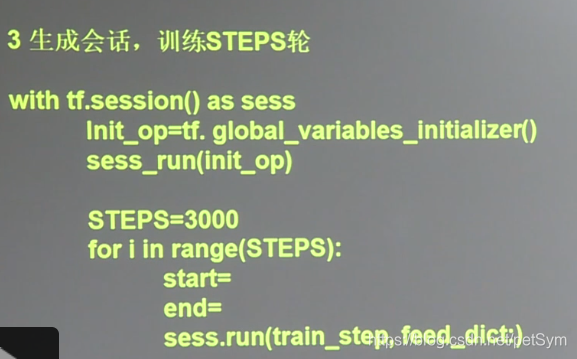############### warm up! ##############
# 均方误差MSE的计算函数:
loss = tf.reduce_mean(tf.square(y_ - y))
# 反向传播的训练方法/优化器:
## 梯度下降
train_step = tf.train.GradientDescentOptimizer(learning_rate).minimize(loss)
## 动量法
train_step = tf.train.MomentumOptimizer(learning_rate).minimize(loss)
## adam
train_step = tf.train.AdamOptimizer(learning_rate).minimize(loss)
############ formal coding! #############
# coding: utf-8
import tensorflow as tf
import numpy as np
import os
os.environ['TF_CPP_MIN_LOG_LEVEL']='2' #hide warnings
BATCH_SIZE = 8 # 一次喂入神经网络多少组数据,不可过大
seed = 23455 # 设置种子使随机生成值一样
#*** np.random.RandomState:伪随机数产生器。seed数值相同,则产生的随机数相同
rng = np.random.RandomState(seed)
#*** 随机数返回32行2列矩阵,表示32组数据,作为输入数据集
X = rng.rand(32,2)
#*** classify the random samples
Y = [[int (x0 + x1 < 1)] for (x0, x1) in X] # pay attention to the square brackets !!!!
#*** show the samples for training
print("X:\n", X)
print("Y:\n", Y)
#*** forward propagation
x = tf.placeholder(tf.float32, shape = (None, 2))
y_= tf.placeholder(tf.float32, shape = (None, 1))
# initiate the weights randomly
w1= tf.Variable(tf.random_normal([2,3], stddev = 1, seed = 1))
w2= tf.Variable(tf.random_normal([3,1], stddev = 1, seed = 1))
# show the compute gragh
a = tf.matmul(x, w1)
y = tf.matmul(a, w2)
#*** back propagation
# define the loss function
loss = tf.reduce_mean(tf.square(y - y_))
# select one training optimizer
train_step = tf.train.GradientDescentOptimizer(0.001).minimize(loss)
# or: MomentumOptimizer
# or: AdamOptimizer
#*** session and train
with tf.Session() as sess:
init_op = tf.global_variables_initializer()
sess.run(init_op)
# print w1 & w2 before training
print("w1 and w2 before training:\n")
print("w1:\n", sess.run(w1))
print("w2:\n", sess.run(w2))
print("\n")
# training
STEPS = 3000
for i in range(STEPS):
# 共32组数据,BATCH_SIZE为8,0-8,8-16,16-24,24-32,然后再循环,共3000轮
start = (i*BATCH_SIZE) % 32
end = start + BATCH_SIZE
sess.run(train_step, feed_dict = {x: X[start:end], y_: Y[start:end]})
# print total loss every 500 rounds
if i % 500 == 0:
total_loss = sess.run(loss, feed_dict = {x: X, y_: Y}) # feed in all the data
print("w1 and w2 after %d training steps, loss on all data is: %g" %(i, total_loss))
print("\n")
print("w1:\n", sess.run(w1))
print("w2:\n", sess.run(w2))
################### 神经网络搭建八股 #################
# 1.准备
## import modules
## define constants
## prepare datasets
# 2.前传
## define x, define correct answer y_
## initialize w1 w2... (randomly)
## define the compute relationshipe a and y (matrix multiple)
# 3.反传
## define loss funtion
## select one back propagation method train_step
# 4.迭代
## use " with tf.Session() as sess: " to iterate
## use " Init_op = tf.global_variables_initializer() " to initialize
## use " sess.run(init_op) " to run/compute the neural network
## use " for i in range(STEPS) " to iterate
################### 迭代细节 #################
